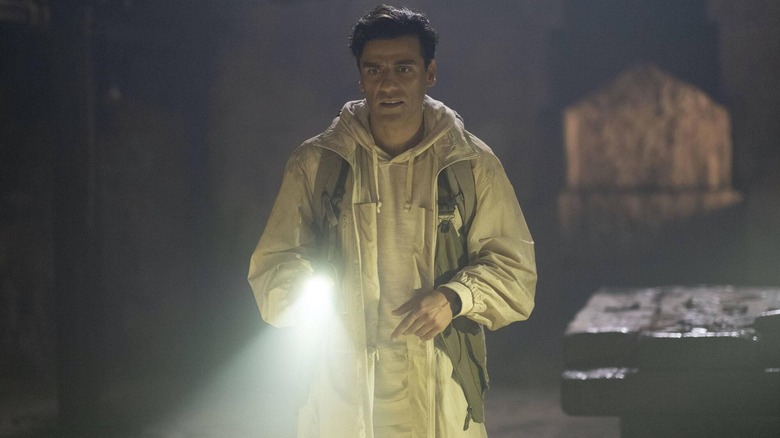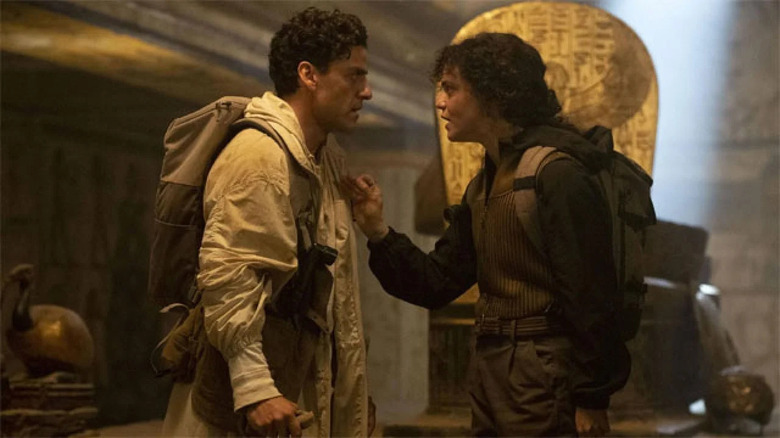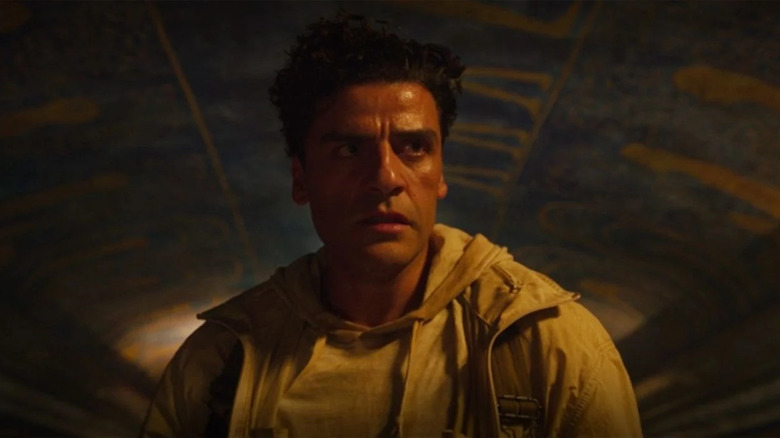Moon Knight Cinematographer On The Pitfalls Of Making TV Shows Too Dark [Exclusive]
Watching the first four episodes of "Moon Knight" on Disney+, there's never a moment when you're not able to see what was happening on the screen. That has not been true for other shows and films. Some fans have been frustrated by this in the past, particularly a certain "Game of Thrones" episode in the final season where some scenes were too dark to make out any of the action.
In the fourth episode of "Moon Knight," there are scenes (yes, there are some mild spoilers ahead), that take place in a tomb, famously not well-lit places. In our /Film interview with cinematographer Andrew Droz Palermo, who worked on episodes 2 and 4 of "Moon Knight," Palermo addresses the challenges of dark scenes and how those scenes are viewed.
When asked about episode 4 in terms of darkness, Palermo said:
I think under exposure is [laughs], it seems like it's a point of contention for a lot of people and like, "How dark is acceptable?" I have a nice TV at home and I can see it in a way that is bright and I know that in the 4K HDR, it looks like it should. So you kind of just worry about how underlit can you get, what's acceptable for everyone's TV. Because I'm in a good environment when I'm in the post-production facility, it's as good as it's going to get there. Everything's calibrated, the monitors are incredible, but you have to remember not everyone has this experience. Not only in the environment that you're coloring in — which is quite dark, there's no windows — but also their TVs aren't as nice.
Palermo explained that he tried to over-light it so that they could change it. "That's generally my methodology, is to do a little more and then bring it down, just so I don't paint us into a corner where you can't see anything."
It's a lovely thing to hear, especially when that's your pet peeve.
Test for the worst, get the best
It's an important thing to remember, that not everyone had access to a nice TV. Many people can't afford one, or when they do get one, they don't know how to set it up. These aren't just plug-in-and-play devices anymore, and you practically need a degree to set them up correctly. I'm glad he mentioned that, and it's something that goes across audio/visual arts. When you're working on mastering music for instance, you mix something on the very best equipment in the perfect setting to listen to — and then you go play it on a crappy radio. The thought is that, if it doesn't sound good there, it's not done, because most people are going to be listening to it that way.
When you're talking about a visual art, there is no excuse. You can light it and edit it for the way you want to see it if you have the optimal specs, but if most people can't see what's happening ... well, this is a storytelling medium, and if half of your audience can't see the action, you're not telling the story. I want to be clear again though; I never noticed things being too dark in "Moon Knight." It's just something that I've seen in the past.
Palermo said that it's frustrating as a cinematographer when he hears that people can't see things.
"As I've mentioned, the viewing experiences in post-production are so good. I know that you should be seeing something. And I know I push things to their limit sometimes, but I know when I'm watching something, I know exactly where I am. So maybe sometimes it's compression. Maybe it's sometimes a streaming service, or one's TV, but it can be frustrating to not have a unified, everyone is seeing it the same way."
There are creative ways around this issue
It's a fine line to tread. He mentioned pushing things to their limit, and sometimes a little darkness adds to the mood and the story. You don't need everything to be clear as day all the time. It's just that, if a plot point is important for the audience to see, they should be able to see it. Palermo mentioned theaters as well, and having seen this myself, it's important. He said that sometimes projectors aren't in the best shape or the bulb hasn't been changed.
"It's a challenge. I feel like horror scenes need darkness. However, you have to keep in mind that not everyone can see everything at every time," he laughed. "So it's a real challenge."
It's a legitimate argument. On the one hand, how do you light a scene so that people can see it even with a crappy TV, but still give ambiance to that scene in a way that people with great TVs don't see it starkly lit and bright? How can you account for everyone's wifi and streaming signal strength? I certainly don't have an answer. All I can think of is to maybe consider more creative ways to change a mood. In the fourth episode of "Moon Knight," for instance, in the temple scene. The creative use of oil lamps behind the ushabtis lit a dark scene in a way that let us see what we needed to, but still gave us the ambiance of a dark and frightening space.
Or the dark scene where Layla is running around the back of the van. When the headlights from the other vehicle hit her face, we see what we need to. (I say this having watched the scene on a monitor that isn't exactly the highest quality.) The flashlights in the tomb, lighting just the parts we need to see, or the glowing light from above was a fantastic example of the way to do it right. Light what you want us to see. In the end, the darkness of the tomb was in such stark contrast to the final parts of the episode that it worked even better.
"Moon Knight" episodes 1-4 are available now on Disney+. Episode 5 releases on Wednesday April 27, 2022.



